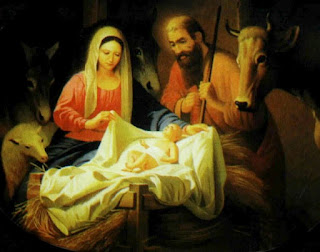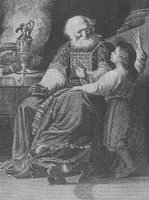 Samuel was the final Old Testament judge. Besides Deborah and an anonymous man in Judges 6:7-10, he is the first prophet mentioned after Moses, although we could consider some of the other judges among the prophets. He lived during the 11th century B.C. Samuel's mother Hannah was unable to have children and she prayed desperately before the tabernacle that the Lord would grant her to bear children to her husband Elkanah, an Ephraimite. Because the Lord heard and answered, Hannah called her son "Samuel," which can be translated "heard by God." This account is in the first chapter of 1 Samuel.
Samuel was the final Old Testament judge. Besides Deborah and an anonymous man in Judges 6:7-10, he is the first prophet mentioned after Moses, although we could consider some of the other judges among the prophets. He lived during the 11th century B.C. Samuel's mother Hannah was unable to have children and she prayed desperately before the tabernacle that the Lord would grant her to bear children to her husband Elkanah, an Ephraimite. Because the Lord heard and answered, Hannah called her son "Samuel," which can be translated "heard by God." This account is in the first chapter of 1 Samuel.In response to God's love for them, Samuel's parents dedicated him to the Lord's service: "And when she had weaned him, she took him up with her, along with a three-year-old bull, an ephah of flour, and a skin of wine, and she brought him to the house of the Lord at Shiloh. And the child was young. Then they slaughtered the bull, and they brought the child to Eli [the priest in the Lord's house]. And she said, 'Oh, my lord! As you live, my lord, I am the woman who was standing here in your presence, praying to the Lord. For this child I prayed, and the Lord has granted me my petition that I made to him. Therefore I have lent him to the Lord. As long as he lives, he is lent to the Lord.' (1:24-28)" He entered sacred service and trained in the house of the Lord at Shiloh under Eli.
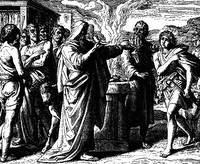 God called Samuel to speak for Him in a series of night messages and established him as His prophet. One of Samuel's most difficult assignments came immediately after his call. Eli was allowing his sons to abuse their priestly offices and through the young man, the Lord condemned their behavior and pronounced God's judgment upon them (see chapter 3).
God called Samuel to speak for Him in a series of night messages and established him as His prophet. One of Samuel's most difficult assignments came immediately after his call. Eli was allowing his sons to abuse their priestly offices and through the young man, the Lord condemned their behavior and pronounced God's judgment upon them (see chapter 3).Samuel's own life didn't always go smoothly. Just as Eli's sons had betrayed their sacred trust as priests, so also "Joel and ... Abijah ..." the sons of Samuel, became unrighteous judges who "took bribes and perverted justice. (8:1-3)" Perceiving this as a problem in God's leadership as well as that of Samuel, Israel demanded that they be given a king such as the surrounding nations had. Samuel warned them that this would lead to even more problems and woes, but when they kept insisting, the Lord told him to do as the people requested.
Samuel anointed Saul to be Israel's first king (10:1). Because of Saul's continuing, flagrant disregard for God's Word, Samuel repudiated Saul's leadership and traveled to the house of Jesse, where he anointed David to be king in place of Saul (16:13).
Samuel's loyalty to God, his spiritual insight, and his ability to inspire others made him one of Israel's great leaders. When he died, "all Israel assembled and mourned for him, and they buried him in his house at Ramah. (25:1a)"
For more on this man of God, see an earlier post that focuses on a series of deceiving appearances in his life.
Labels: biography, commemoration, david, eli, hagiography, hannah, israel, judges, old testament, prophet, samuel, saul
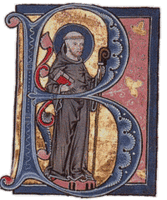 ernard of Clairvaux, a leader in Christian Europe in the first half of the 11th century A.D., is honored in his native France and around the world. Born into a noble Burgundian (Fontaines, near Dijon) family in 1090, he was drawn toward the Church by his own nature and encouraged by his mother's desire. His family opposed His desire to enter a monastery and sent him to study at Châlons in order to qualify him for higher ecclesiastical office. However, Bernard left his affluent heritage, entering the monastery of Citeaux at age 22. He persuaded four of his brothers, an uncle, and 26 other men, mainly the sons of nobles, to join him.
ernard of Clairvaux, a leader in Christian Europe in the first half of the 11th century A.D., is honored in his native France and around the world. Born into a noble Burgundian (Fontaines, near Dijon) family in 1090, he was drawn toward the Church by his own nature and encouraged by his mother's desire. His family opposed His desire to enter a monastery and sent him to study at Châlons in order to qualify him for higher ecclesiastical office. However, Bernard left his affluent heritage, entering the monastery of Citeaux at age 22. He persuaded four of his brothers, an uncle, and 26 other men, mainly the sons of nobles, to join him.After two years he and several others were sent to a new monastic house at Clairvaux, where Bernard soon became its abbot. His work there was blessed in many ways. The monastery at Clairvaux grew in mission and service, eventually establishing some 68 daughter houses.
During the disputed papal elections between Anacletus II and Innocent II, he took the side of Innocent. From 1130-38, Bernard worked to solidify the papal claim through ecclesiastical and secular politics. He battled against the "New Teaching" espoused by Pierre Abélard at the University of Paris, resisting a broad-based liberal arts education using the philosophy of Aristotle. Instead, Bernard insisted that such an education was only to be used in preparation for the priesthood.
At the command of Pope Eugenius III in 1146, Bernard preached in favor of a new effort to free the Holy Land from the Mohammedans. This gave life to the previously moribund Second Crusade. While the results of the campaign were certainly mixed, events during it served to enhance Bernard's perception among non-Christians: When a monk named Radulf (or Raoul) incited the populace of Mainz against the Jews, Bernard vigorously opposed him, calling the monk arrogant, without authority, a preacher of mad and heretical doctrines, a liar, and a murderer. Radulf slipped away, the riots ended, and Bernard became known as a "righteous gentile." His reputation among Rhine valley Jews remained so good that his name is still given to some of their descendants. The most famous of these would probably be American businessman and presidential advisor Bernard Baruch.
Certainly, we remember St. Bernard for his charity and political abilities. Even more, we honor his preaching ability and, especially, his poetry and hymn writing (cf. NetHymnal and Hymnuts at the Internet Archive): The texts of O Jesus, King Most Wonderful (MIDI audio) and O Sacred Head, Now Wounded (MIDI audio), as well as others, remain vital parts of our Christian heritage.
Martin Luther cited Saint Bernard in a number of his writings. When Bernard spoke of justification by grace through faith, Luther commended the teaching. For example, in his commentary on 10, the reformer wrote, "This is the kind of joy and comfort St. Bernard had in his heart, so that he could say, on the basis of this article: 'How can I ever become sad and mournful or discouraged? After all, my flesh and blood sits in heaven above. I expect He will not be my enemy.' For St. Bernard to apply this to himself and to boast this way is certainly a genuinely spiritual, heavenly, and divine thought, derived from his faith. For he had also amounted to something in the world. He had been rich enough, noble, learned, and holy. But before God St. Bernard knows no other boast or comfort than this Lord. (LW 13:245)"
Where Bernard lapsed into exalting the office of the papacy or waxed eloquent on the merits of the saints — particularly Mary — Luther condemned these works as false and misleading. Yet the reformer appreciated and held close the monk's death-bed confession of personal unworthiness and total reliance on Christ's merits: "That is how St. Bernard was saved. He was an exemplary monk; he observed the rules of his order scrupulously, and he fasted so assiduously that his breath stank and no one could abide his presence. But on the threshold of death he exclaimed: 'Oh, I have lived damnably! But heavenly Father, Thou hast given me Thy Son, who has a twofold claim to heaven: first, from eternity, by reason of the fact that He is Thy Son; secondly, He earned heaven as the Son of man with His suffering, death, and resurrection. And thus He has also given and bestowed heaven on me. [Sermones in cantica, Sermon XX, Patrologia, Series Latina, CLXXXIII, 867]' Thereby St. Bernard dropped out of the monastic role, forsook cowl and tonsure and rules, and turned to Christ; for he knew that Christ conquered death, not for Himself but for us men that all who believe in the Son should not perish but have eternal life. And so St. Bernard was saved. (LW 22:360)"
In case you're wondering, the Saint Bernard dog is not named for Bernard of Clairvaux but indirectly for Bernard of Montjoux (or Menthon), an earlier monk who founded a travelers' hospice and monastery in the Pennine Alps and another hospice in the Graian Alps. Both of these passes were later named for him and and the large rescue dogs for these places where they were stationed.
NB: I followed the LCMS Calendar of Commemorations and listed Bernard on 19 August, even though his death date is normally remembered as 20 August and occasionally as the 21st. Roman Catholicism celebrates his feast on the 20th.
Suggested Lection
Psalm 139:1-12 or 19:7-11
Sirach 39:1-10
John 15:7-11
Collect
O God, by whose grace Your servant Bernard of Clairvaux, kindled with the flame of Your love, became a burning and a shining light in your Church, grant that we also may be aflame with the spirit of love and discipline, walking before You as children of light; through Jesus Christ our Lord, who lives and reigns with You and the Holy Spirit, one God, now and for ever.
Be Thou my Consolation, My Shield when I must die;Hymn texts and MIDI audio linked from the Lutheran Hymnal Project.
Remind me of Thy Passion When my last hour draws nigh.
Mine eyes shall then behold Thee, Upon Thy cross shall dwell,
My heart by faith enfold Thee. Who dieth thus dies well!
(P. Gerhardt; from Bernard's Salve caput cruentatum)
Martin Luther quotes from Volume 13: Luther's Works, Selected Psalms II, © 1956 by Concordia Publishing House and Volume 22: Luther's Works, Sermons on the Gospel of St. John: Chapters 1-4, © 1957 by Concordia Publishing House.
Labels: bernard, biography, christianity, church history, clairvaux, commemoration, crusades, hagiography, hymns, medieval history, monasticism
 Born 17 October 1582, Johann Gerhard, a Lutheran theologian in the tradition of Martin Luther (1483-1546) and Martin Chemnitz (1522-86), was the most influential 17th Century dogmatician. Many still consider his Loci Theologici in 23 large volumes to be the most definitive statement of Lutheran orthodoxy. Born in Quedlinburg, Germany, Gerhard was stricken with a life-threatening illness at age 15.
Born 17 October 1582, Johann Gerhard, a Lutheran theologian in the tradition of Martin Luther (1483-1546) and Martin Chemnitz (1522-86), was the most influential 17th Century dogmatician. Many still consider his Loci Theologici in 23 large volumes to be the most definitive statement of Lutheran orthodoxy. Born in Quedlinburg, Germany, Gerhard was stricken with a life-threatening illness at age 15.Following this experience, coupled with with guidance from his pastor, Johann Arndt, Gerhard experienced a turning point: He devoted the rest of his life to theology, serving many years as the Superintendent of Heldberg and, later, of the Duchy of Coburg. Eventually he become a professor at the University of Jena. With a sharp, critically trained mind, Gerhard also possessed deep evangelical piety and love for Jesus.
He wrote exegetical and theological works, devotional literature, history, and polemics. Many of his sermons remain in publication, still exercising wide influence upon confessional Lutheran thought. Since its writing and subsequent translation, his Sacred Meditations probably outsold every book in the Western world except the Bible and The Imitation of Christ by Thomas à Kempis.
His son Johann Ernst Gerhardt was also a Lutheran theologian and professor. An even more noted relative was his nephew, Johannes Andreas Quenstedt.
For more detailed information, see the Studium Excitare, Wikipedia, and the Christian Cyclopedia.
Partial List of Works
† Exegesis: Commentarius in harmoniam historiae evangelicae de passione Christi (A comentary harmonizing the Gospel accounts of Christ's Passion, 1617)
† Exegesis: Comment, super priorem D. Petri epistotam (1641)
† Exegesis: Commentaries on Genesis (1637) and Deuteronomy (1658)
† Theology: Confessio Catholice (Universal Confession, 1633-1637), a defense of the evangelical and catholic nature of the Augsburg Confession
† Theology: Loci communes theologici (1610-1622)
† Devotional: Meditationes sacrae (Sacred Meditations, 1606)
Suggested Lection
Psalm 46
Isaiah 55:6-11
Romans 10:5-17
John 15:1-11
Collect
O Lord God, heavenly Father, pour out Your Holy Spirit upon Your faithful people, keep them steadfast in Your grace and truth, protect and comfort them in all temptation, defend them against all enemies of Your Word, and bestow on Christ's Church Militant Your saving peace; through Jesus Christ, Your Son, our Lord, who lives and reigns with You and the Holy Spirit, one God, now and forever. Amen.
Lord, keep us steadfast in Your Word!
Labels: biography, christianity, church history, commemoration, german history, hagiography, johann gerhard, lutheranism, martin chemnitz, martin luther, theology
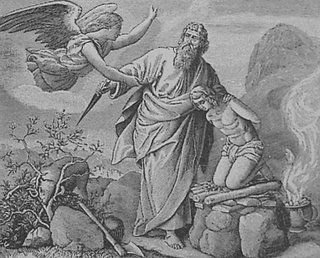 If any part of Scripture besides the Resurrection clearly indicates that God gets the last laugh, it must be the story of Isaac.
If any part of Scripture besides the Resurrection clearly indicates that God gets the last laugh, it must be the story of Isaac.After giving new names to Abraham and Sarah, the Lord promised a them a son. At the time, Abraham was 99 and Sarah was 90 (see Genesis 17). When Abraham heard the news, he "fell on his face and laughed and said to himself, 'Shall a child be born to a man who is a hundred years old? Shall Sarah, who is ninety years old, bear a child?' (v. 17)"
In response to the laughter and doubting, the Lord said, "Sarah your wife shall bear you a son, and you shall call his name Isaac. I will establish my covenant with him as an everlasting covenant for his offspring after him. (v. 19)" Isaac means "He Laughs."
To reiterate His point, the Lord allowed Sarah to overhear Him repeat His promise to Abraham at the Oaks of Mamre (see Genesis 18). "So Sarah laughed to herself, saying, 'After I am worn out, and my lord is old, shall I have pleasure?' The Lord said to Abraham, 'Why did Sarah laugh and say, "Shall I indeed bear a child, now that I am old?" Is anything too hard for the Lord? At the appointed time I will return to you about this time next year, and Sarah shall have a son.' But Sarah denied it, saying, 'I did not laugh,' for she was afraid. He said, 'No, but you did laugh.' (vv. 12-15)"
Sure enough, things happened not as Abraham and Sarah may have expected, but as the Lord had planned and promised. When Abraham was 100 years old, Sarah gave birth and "Abraham called the name of his son who was born to him, whom Sarah bore him, Isaac. (21:3)" Sarah likewise reveled in the irony: "God has made laughter for me; everyone who hears will laugh over me. (v. 6)"
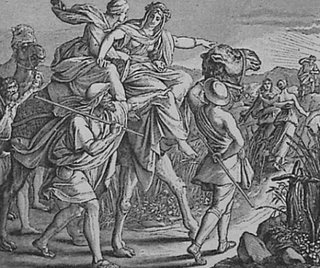 When Isaac was a young man, Abraham took him to Mount Moriah. There, Abraham, obeying God's command, prepared to sacrifice his son as a burnt offering. But God intervened, sparing Isaac's life and providing a ram as a substitute offering (22:1-14).
When Isaac was a young man, Abraham took him to Mount Moriah. There, Abraham, obeying God's command, prepared to sacrifice his son as a burnt offering. But God intervened, sparing Isaac's life and providing a ram as a substitute offering (22:1-14).In so doing, God also pointed to the substitutionary sacrifice of His own Son Jesus Christ for the sins of the world. When the author of Hebrews expounded on the faith of Abraham (11:8-19), he made special note of Abraham's belief that, in order to accomplish His purposes, "God was able even to raise [Isaac] from the dead, from which, figuratively speaking, he did receive him back. (v. 19)"
Abraham sent a faithful servant back among their kinfolk in order to find a bride for Isaac. There, the servant found Rebekah, who gladly traveled with this stranger to a new land, where she was given in marriage to Isaac (Genesis 24). They had twin sons, Esau and Jacob (25:19-26).
In his old age, Isaac became weak and blind. Before he died, he desired to give his blessing and the chief inheritance to Esau, his elder and favorite son, even though the Lord had promised Rebekah that their birth order would be reversed in the blessing and Jacob would be the favored son (25:23). However, Rebekah showed her favorite, Jacob, how to deceive his father and gain the blessing for himself (27:1-40). Of course, this resulted in years of bitter family strife, although Jacob and Esau later reconciled (Genesis 33).
Isaac lived to the age of 180 and was buried by his sons in the family burial cave of Machpelah (35:28-29).
Labels: abraham, biography, christianity, christology, commemoration, hagiography, isaac, israel, jacob, old testament, rebekah, sacrifice, sarah
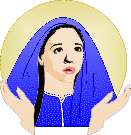 The honor paid to Saint Mary, the virgin mother of Jesus Christ our Lord, God, and Savior goes back to the earliest days of the Church. Indeed, it goes back farther: Even before the birth of her Son, Mary prophesied, "From now on all generations will call me blessed. (Luke 1:48 ESV)" Confessing her as "Mother of God" also confesses that the One whom she bore was and is, indeed, true God.
The honor paid to Saint Mary, the virgin mother of Jesus Christ our Lord, God, and Savior goes back to the earliest days of the Church. Indeed, it goes back farther: Even before the birth of her Son, Mary prophesied, "From now on all generations will call me blessed. (Luke 1:48 ESV)" Confessing her as "Mother of God" also confesses that the One whom she bore was and is, indeed, true God.The New Testament records several incidents from the life of the Virgin: her betrothal to Joseph, the Annunciation by the angel Gabriel that she was to bear the Messiah, her Visitation to Elizabeth the mother of John the Baptist, the Nativity of our Lord, the visits of the shepherds and the magi, her Purification and the Presentation of the infant Jesus in the Temple at the age of forty days, the flight into Egypt, the Passover visit to the Temple when Jesus was twelve, (Matthew 1:16, 18-25; Matthew 2; Luke 1:26-56; Luke 2); the wedding at Cana in Galilee and the performance of her Son's first miracle (at Mary's intercession, see John 2:1-11), the occasions when observers basically said of Jesus, "How can this man be special? We know his family!" (Matthew 13:54-56; Mark 6:1-3; Luke 4:22; see also John 6:42); an instance when she came with others to see Him while he was preaching (Matthew 12:46-50; Mark 3:31-35; Luke 8:19-21); and her presence at His crucifixion, where Jesus commended her to the care of His Beloved Disciple (John 19:25-27). Mary was also present with the apostles in Jerusalem following the Ascension, waiting for the promised Spirit (Acts 1:14). Thus, we see her present at many of the chief events of her Son's life.
Besides Jesus, only two people are mentioned by name in the Creeds. One is Pontius Pilate, Roman procurator of Judea from 26 to 36 AD. Knowing that Jesus was crucified by Pilate's order pins down the date of His death within a few years, certifying that we are not talking "once upon a time," like worshipers of some mythical god. His death is an historical event, something that really happened.
The other name in the Creeds is that of Mary. They say that Christ was "born of the virgin Mary." That is, they assert that he was truly and fully human, born of a woman and not descended from the skies like an angel. Jesus was not a spirit temporarily cloaked in a robe of human-seeming flesh.
Telling us that His mother was a virgin excludes the theory that Jesus was an ordinary man who was so virtuous that he eventually, at His baptism, became filled with a "Christ Spirit" by God. His virgin birth attests that He was always more than merely human, always one whose presence among us was in itself a miracle, from the first moment of His earthly existence. In Mary, Virgin and Mother, God gives us a sign that Jesus is both truly God and truly man. Emphasizing this point, the Council of Ephesis in AD 431 officially titled her Theotokos (God-bearer) and rejected and condemned the title Christotokos (Christ-bearer). Ask the Pastor comments on the distinction in Blessed Virgin Mary: Mother of God.
We know Little of Mary's life except as it intersects with the life of her Son; this is appropriate. The Scriptures record her words to the angel Gabriel, to her kinswoman Elizabeth, and to her Son on two occasions. The only recorded saying of hers to "ordinary" hearers is her instruction to the servants at the wedding feast: "Do whatever he [Jesus] tells you. (John 2:5 ESV)" Perhaps this should be the summation of her message to the world. To this day, she reminds us, "Listen to Jesus. Pay attention to my Son. Do as He says."
She didn't seek the regard of others on her own behalf. If our honor for the Blessed Virgin doesn't turn our attention from her to the One whom she bore and suckled, to the Word made flesh, then we may be certain that it is not the blessing that she seeks. A right regard for Mary always directs us to Him who made her womb His first earthly dwelling-place.
In different parts of the Church, the date is remembered in various ways. Roman Catholicism celebrates the Assumption of Mary and claims that she was taken, body and soul, to heaven. However, I've found contradictory teachings in the Roman Church, arguing whether she was translated in the manner of Enoch or Elijah, if she died and was resurrected on earth and then taken to heaven, or if her dead body was taken and then rejoined with her soul in heaven.
Meanwhile, Eastern Orthodoxy celebrates the Dormition of the Theotokos. It claims that Mary certainly died but that when Thomas visited three days later, her body was gone from the tomb. As to whether the body will be kept in heaven until the general resurrection on the Last Day or already rejoined with her spirit, Orthodoxy will not make a final dogmatic pronouncement.
In the rest of Christendom that follows a sanctorial calendar, the general belief seems to be that she likely died and awaits the resurrection with all others who departed in the Faith.
Lection
Psalm 45:10-17
Isaiah 61:7-11
Galatians 4:4-7
Luke 1:(39-45) 46-55
Collect of the Day
Almighty God, You chose the virgin Mary to be the mother of Your only Son. Grant that we, who are redeemed by His blood, may share with her in the glory of Your eternal kingdom; through Jesus Christ, Your Son, our Lord, who lives and reigns with You and the Holy Spirit, one God, now and forever.
or
Grant, we humbly pray, O Lord, to Your servants the gift of Your heavenly blessing that, as the Son of the Virgin Mary has granted us salvation, we may daily grow in Your favor; through Jesus Christ, Your Son, our Lord, who lives and reigns with You and the Holy Spirit, one God, now and forever.
Labels: acts, assumption, biography, christianity, creed, dormition, feasts, festivals, gospels, hagiography, jesus, mary, new testament, theotokos, virgin
 A river, a gulf, and a seaway are named in his honor. A number of Christian congregations and almost anyone known as "Larry" likewise owe their names to this martyr of the ancient Christian Church.
A river, a gulf, and a seaway are named in his honor. A number of Christian congregations and almost anyone known as "Larry" likewise owe their names to this martyr of the ancient Christian Church.Early in the third century A.D., Lawrence (Latin, Laurentius, also often known as "Lorenz," "Laurence," or "Lorenzo"), who was most likely born in Spain, made his way to Rome. There he was appointed chief of the seven deacons and was given the responsibility to manage church property and finances.
The emperor at the time, thinking that the church had valuable things worth confiscating, ordered Lorenz to produce the "treasures of the church." Saint Lorenz brought before the emperor the poor whose lives had been touched by Christian charity. He was then jailed and eventually executed in the year 258. Many accounts tell of his being roasted on a gridiron until dead. However, some scholars think that this tradition came about due to a faulty transcription and that the phrase assus est (he roasted) should have been rendered passus est (he suffered).
His martyrdom left a deep impression on the young church. Almost immediately, the date of His death, 10 August, became a permanent fixture on the commemorative calendar of the early Church.
Lection
Psalm 65:1-8 or 34:1-10
Deuteronomy 33:1-3 or Isaiah 26:1-4, 8-9, 12-13, 19-21
Revelation 7: 2-17 or 21:9-11, 22-27; 22:1-5
Matthew 5:1-12
Collect
Stir up, O merciful Father, Your people to true brotherly affection that we may gladly do good and serve our neighbor, as did Your servant Saint Lawrence, when he emptied the treasure of the Church to help the poor; through our Lord Jesus Christ, who lives and reigns with You and the Holy Spirit, one God, now and forever.
Labels: biography, christianity, church history, commemoration, feasts, hagiography, lawrence, lorenz, martyrdom, roman empire
 Lutheran pastor and theologian Hermann Otto Erich Sasse was born on 17 July 1895 at Sonnewalde, Lower Lusatia (Lausitz), Germany. He was the eldest of five children born to pharmacist Hermann Sasse and his wife Maria, née Berger. In 1913,he began reading theology and ancient philology at the University of Berlin. In later years, he claimed that his tutor in practical theology was war, as he was one of only six survivors from his battalion after engaging in trench warfare in Flanders.
Lutheran pastor and theologian Hermann Otto Erich Sasse was born on 17 July 1895 at Sonnewalde, Lower Lusatia (Lausitz), Germany. He was the eldest of five children born to pharmacist Hermann Sasse and his wife Maria, née Berger. In 1913,he began reading theology and ancient philology at the University of Berlin. In later years, he claimed that his tutor in practical theology was war, as he was one of only six survivors from his battalion after engaging in trench warfare in Flanders.After the war, he continued his studies and was ordained in 1920 in St Matthew's Church, Berlin. He served in several Brandenburg parishes took the licentiate in theology in Berlin in 1923. Sasse came to Hartford Seminary, Connecticut in 1926, where he earned a master's degree.
Hermann Sasse married Charlotte Margarete Naumann (d. 1964) on 11 September 1928 in St. Nicolai's Church, Oranienburg, Germany. Their union was blessed with three children.
During the tough economic times of the Great Depression, During the Depression, Sasse was made a Sozialpfarrer (pastor with social duties). As such, he reached out to those in need in the community, particularly to factory workers in Berlin.
Although remembered as one who resisted the watered-down theology of unionism, Sasse participated in the Ecumenical Movement and was a delegate and interpreter during the first world conference of the Faith and Order Movement in Lausanne, Switzerland (1927). He also attended the 1932 disarmament conference in Geneva.
Among German theologians, he ranks as one of the the earliest to speak out against Nazism. While criticizing some of its theology, he participated actively in the Confessing Church Movement that had emerged under Martin Niemöller and others. Sasse and Dietrich Bonhoeffer were among the small but growing church opposition to Hitler. In 1933, they were the primary authors of the Bethel Confession. This strongly trinitarian document also clearly condemned discrimination against the Jews. Rejecting an all-Aryan German Church, the Confession stated, "Instead of giving up, either willingly or unwillingly, in one area the ecclesial fraternity with the Jewish Christian that is created by word and sacrament, the Gentile Christians should rather expose themselves to persecution."
 Although he'd been working hand-in-hand with its members, Sasse left the synod that produced the Barmen Declaration. He objected to Karl Barth and others leading the Confessing Movement to wrongly arrogate church authority for itself. During this time, he continued as professor in church history at the University of Erlangen, Bavaria, a position he received in 1933. The German government withdrew his passport in 1935 but his popularity as a lecturer and protection from the dean of the faculty helped him to retain his university post through the Nazi era.
Although he'd been working hand-in-hand with its members, Sasse left the synod that produced the Barmen Declaration. He objected to Karl Barth and others leading the Confessing Movement to wrongly arrogate church authority for itself. During this time, he continued as professor in church history at the University of Erlangen, Bavaria, a position he received in 1933. The German government withdrew his passport in 1935 but his popularity as a lecturer and protection from the dean of the faculty helped him to retain his university post through the Nazi era.Uncomfortable with its theological compromises, Sasse protested at the 1948 formation of the Evangelical Church in Germany. His opposed its policy of restoration rather than renewal and expressed disquiet over state-supported university faculties of theology. This led him to join the Lutheran Free Church.
After receiving a call to teach at Immanuel Seminary (now Australian Lutheran College) in North Adelaide, South Australia, he migrated in 1949. There, he worked mightily to unite Australia's divided Lutheran churches, devoting much energy to this cause. Exercising his considerable teaching and writing skills, he helped to formulate and forge new doctrinal bases of agreement and was rewarded by seeing the 1966 church union.
Sasse stayed active in the German Lutheran communities of Adelaide and Melbourne. Through his many contacts, he assisted immigrants with pastoral advice and care.
Sasse also retained his global Lutheran connections — many in the United States knew him as "Mr. Lutheran." He maintained world-wide correspondence through regular doctrinal and pastoral "Letters to Lutheran Pastors." He continued to encourage ongoing theological research, particularly in the areas of Scripture as Word of God and the Eucharist. While maintaining his justly deserved reputation for strongly defending confessional and conservative positions, Sasse also kept active personal contacts across denominational boundaries.
 From its inception, Sasse involved himself in Australian Roman Catholic-Lutheran dialog. He finally retired from the seminary in 1969 but stayed active in the affairs of the Church. The Federal Republic of Germany honored him with the Order of Merit in 1972.
From its inception, Sasse involved himself in Australian Roman Catholic-Lutheran dialog. He finally retired from the seminary in 1969 but stayed active in the affairs of the Church. The Federal Republic of Germany honored him with the Order of Merit in 1972.Sasse saw over 450 of his works published. Included among them are Here We Stand (Minneapolis, 1946) and This is My Body (1959). A fire in his North Adelaide home claimed his life on 9 August 1976. Survived by two sons, he was buried in Centennial Park, Pasadena, South Australia. One obituary declared Sasse "Australia's most distinguished acquisition from the Continental theological scene."
Hermann Sasse was one of many who stood steadfast in confession of the Evangelical, Orthodox, Catholic, and Apostolic Faith. For a sampling of some of the others in Lutheranism, please see The Meanies of Grace. For more on and by Sasse, I recommend What Sasse Said and Hermann Sasse and the Liturgical Movement as possible starters. You can also find plenty of Sasse to read through this CPH search.
Suggested Lection
Psalm 46
Isaiah 55:6-11
Romans 10:5-17
John 15:1-11
Collect
O Lord God, heavenly Father, we pray that, as You raised up Hermann Sasse to resist the evils of Nazi philosophy and through him led Lutherans in Germany, Australia, and around the world into renewed appreciation of their confessional heritage and trust in the saving Gospel of Jesus Christ, so You would continue to provide Your Church with faithful pastors and leaders, keeping them steadfast in Your grace and truth, defending them against all enemies of Your Word, and bestowing on Christ's Church Militant Your saving peace; through Jesus Christ, Your Son, our Lord, who lives and reigns with You and the Holy Spirit, one God, now and forever.
Labels: australia, biography, christianity, church history, commemoration, confessionalism, ecumenical movement, german history, germany, hagiography, lutheranism, sasse, theology
 These "myrrh bearers" or "faithful women," as they're called among some Christians, with Mary Magdalene, are named in Scripture as the first visitors to the tomb of the crucified Christ early on the first day of the week. Their trek to His sepulcher was recorded in each of the Synoptic Gospels, although each includes different details. (see Matthew 28:1-8, Mark 16:1-8, and Luke 24:1-11).
These "myrrh bearers" or "faithful women," as they're called among some Christians, with Mary Magdalene, are named in Scripture as the first visitors to the tomb of the crucified Christ early on the first day of the week. Their trek to His sepulcher was recorded in each of the Synoptic Gospels, although each includes different details. (see Matthew 28:1-8, Mark 16:1-8, and Luke 24:1-11).Joanna was the wife of Chuza, a steward in Herod's household (Luke 8:3). Mary, the mother of James the son of Alphaeus, also faithfully provided care for Jesus and His disciples from the time of His Galilean ministry through His burial after the crucifixion. Salome, the mother of the sons of Zebedee (Matthew 27:56), joined with the women both at the cross and in the bringing of the spices to the garden tomb.
These "faithful women" have been honored in the Church throughout the centuries as examples of humble and devoted service to the Lord.
Suggested Lection
Psalm 45:1-9
1 Corinthians 15:1-11
Luke 23:54-24:11 or Mark 16:1-8
Suggested Collect
Blessed Lord, through Your only-begotten Son You overcame death and by Your Holy Spirit You call us to Him that we might believe and be saved. Grant that as the women came to His tomb on Easter morn and found joy where they expected sorrow, so we might also come to Christ Jesus, casting our cares upon Him and receiving forgiveness, peace, and the sure and certain hope of everlasting life through Him who reigns eternally with You and the Holy Spirit, one God, now and forever.
Labels: biography, commemoration, easter, gospels, hagiography, jesus, joanna, mary, mary magdalene, new testament, resurrection, salome

